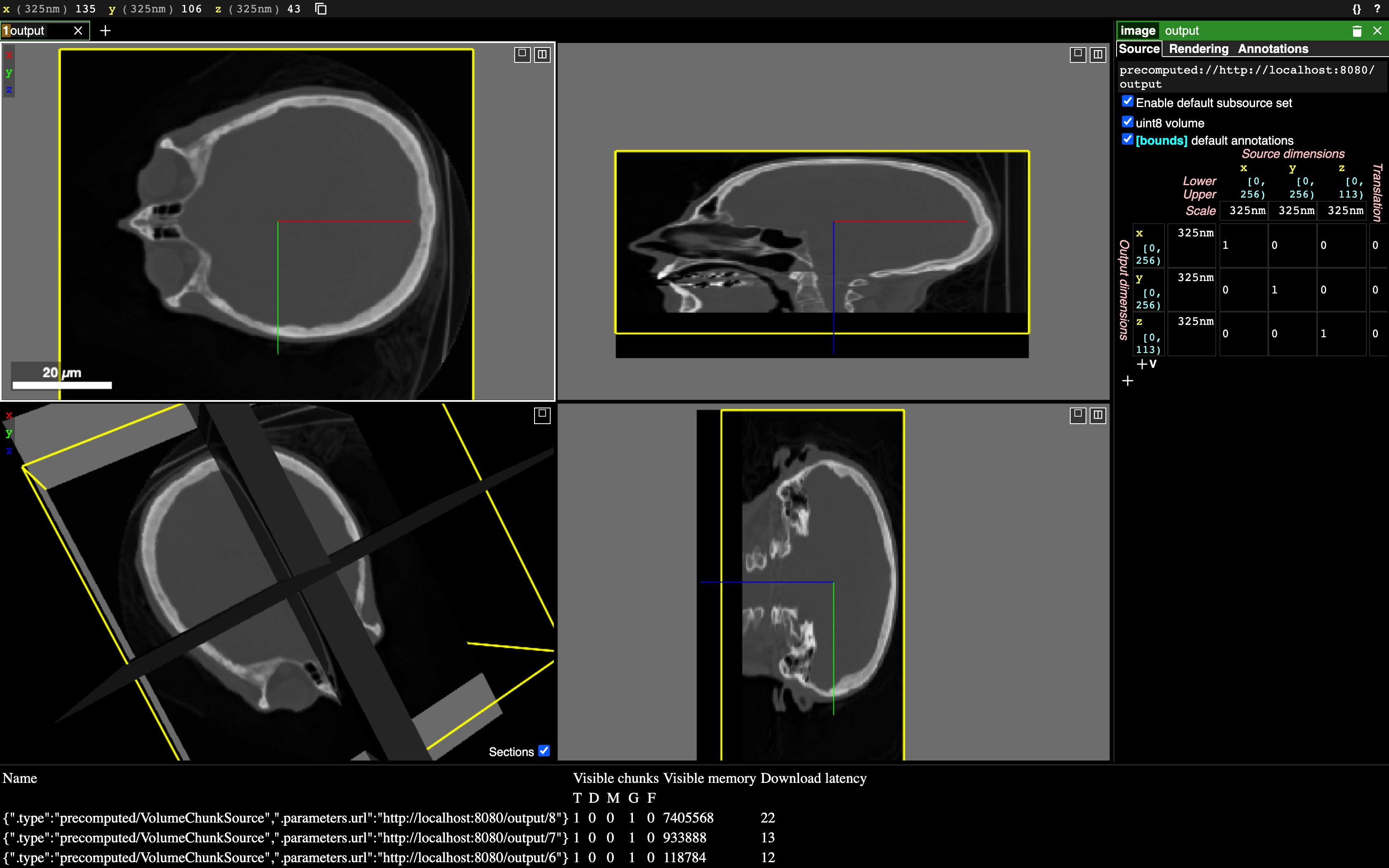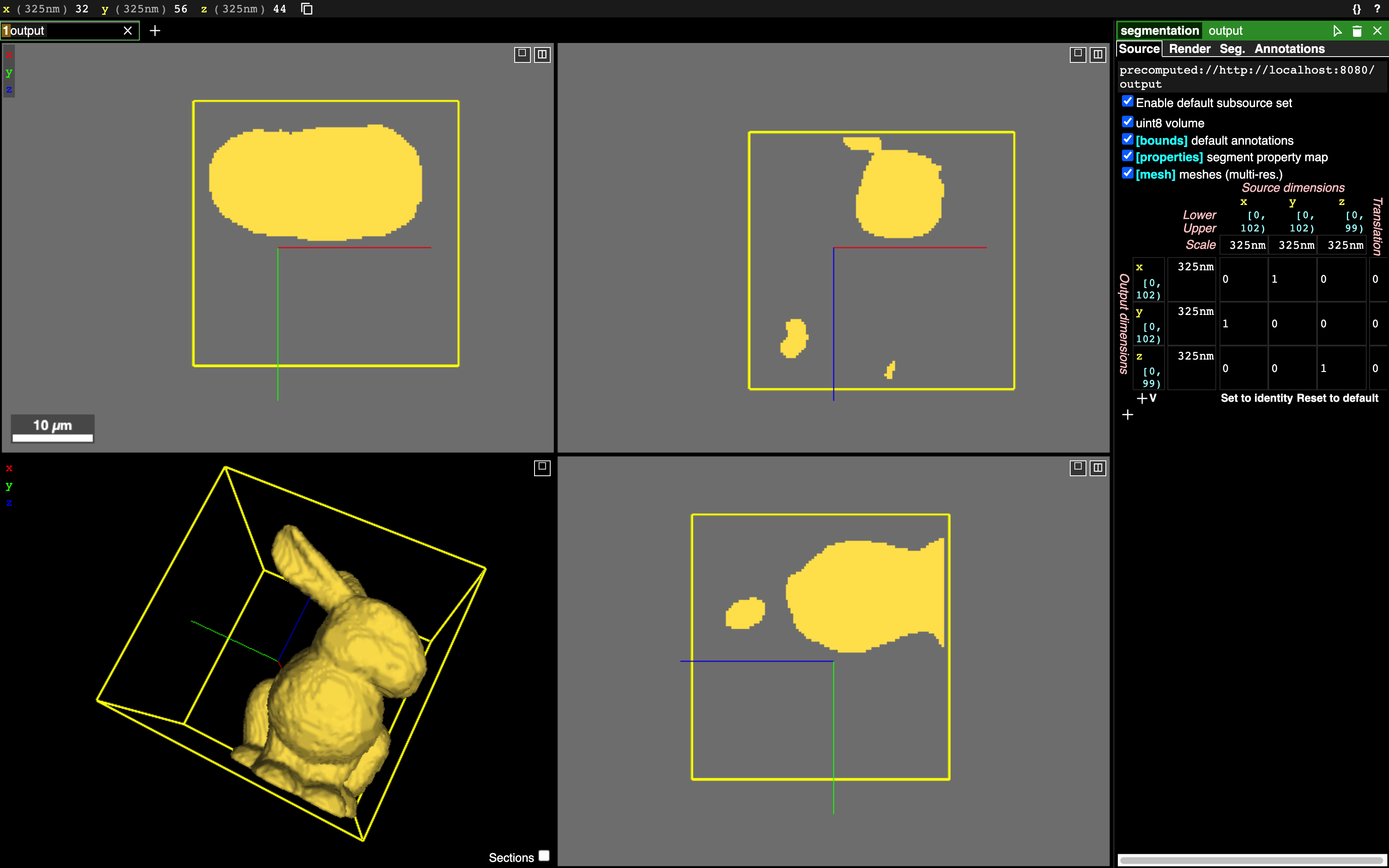Neurogen
Neurogen is a library for converting data into compatible formats with Neuroglancer. The two types of outputs it can create are:
- Volume generation
- Mutli-resolutional meshes
Installation
After cloning the repository with --recurse-submodules run the following:
pip install neurogen
To set up a local Neuroglancer environment: https://github.com/google/neuroglancer#building
Volume Generation Example
Working with the following example: http://graphics.stanford.edu/data/voldata/
Download example data and unzip in appropriate directory:
mkdir cthead
wget http://graphics.stanford.edu/data/voldata/cthead-8bit.tar.gz
tar xvf cthead-8bit.tar.gz -C cthead
Using Neurogen to generate the volume data:
import os
import numpy as np
from imageio import imread
from neurogen import info as nginfo
from neurogen import volume as ngvolume
# Input and output directories.
input_dir = 'cthead/'
output_dir = 'output/'
# Generate Input.
volume = np.zeros((256,256,113,1,1)).astype('uint8')
for filename in os.listdir(input_dir):
imarray = imread(os.path.join(input_dir, filename)).astype('uint8')
index = int(filename[11:14])
volume[:,:,index,0,0] = imarray
# Generate Neuroglancer volume.
volume_info = nginfo.info_image(directory=output_dir,
dtype=volume.dtype,
chunk_size=[256,256,256],
size=volume.shape)
ngvolume.generate_recursive_chunked_representation(
volume,
volume_info,
dtype=volume.dtype,
directory=output_dir,
blurring_method='average'
)Mesh Generation Example (with Volume Generation)
Download a high resolution version of the Standford Bunny from https://www.thingiverse.com/thing:11622
wget https://cdn.thingiverse.com/zipfiles/f0/90/b2/26/36/High_Resolution_Stanford_Bunny.zip
unzip High_Resolution_Standford_Bunny.zip
mkdir bunny_pngs
git clone https://github.com/cpederkoff/stl-to-voxel
python stl-to-voxel/stltovoxel.py High_Resolution_Stanford_Bunny/StanfordBunny_jmil_HIGH_RES_Smoothed.stl bunny_pngs/bunny.png
import os
import imageio
import numpy as np
from neurogen import volume as ngvolume
from neurogen import mesh as ngmesh
from neurogen import info as nginfo
from skimage import measure
# Unzip tar file into appropriate directory
input_dir = 'bunny_pngs/'
output_dir = 'output/'
# Generate Input
volume = np.zeros((102,102,99,1,1)).astype('uint8')
for png in os.listdir(input_dir):
im = imageio.imread(os.path.join(input_dir, png))
index = int(png[5:8])
volume[:,:,index,0,0] = im
ids = np.unique(volume[volume > 0])
info = nginfo.info_mesh(directory=output_dir,
dtype=volume.dtype,
chunk_size=[256,256,256],
size=volume.shape,
ids=ids,
labelled_ids = ['bunny'],
segmentation_subdirectory = 'segment_properties')
ngvolume.generate_recursive_chunked_representation(volume,
info, dtype=volume.dtype, directory=output_dir)
for segment_id in ids:
# Generate mesh for each segment.
vertices, faces, _, _ = measure.marching_cubes((volume[:,:,:,0,0] == segment_id).astype('uint8'), level=0, step_size=1)
ngmesh.fulloctree_decomposition_mesh(vertices, faces, num_lods=1, segment_id=segment_id, directory=output_dir)License
Neurogen is provided under an MIT license that can be found in the LICENSE file. By using, distributing, or contributing to this project, you agree to the terms and conditions of this license.

